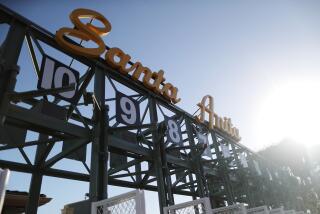Latest horse death at Santa Anita leaves racing’s giants fearing the worst
- Share via
The television cameras lined up horizontally every 15 feet, facing the Santa Anita racetrack with the San Gabriel Mountains in the background, a view that for the horse racing industry has become an unwelcome staple of morning television.
It was here Monday morning that track operators, trainers, jockeys and media specialists once again tried to convince viewers that every possible thing was being done to stem the rise of horse deaths at Santa Anita. Less than 24 hours earlier, the 23rd horse since Dec. 26 died at the track.
Sunday’s fatality occurred on the dirt crossing of the turf course, a unique layout that goes from the top of the hill behind the track, takes a slight right turn, then, near the top of the stretch, swings left as the horses transition from grass to 80 feet of dirt before returning to the turf. A 5-year-old gelding named Arms Runner fell, apparently after injuring his right front leg. A trailing horse tripped over the fallen horse but got up and was fine. Both jockeys were OK. Arms Runner was euthanized.
“You look at that horse; he was a low-risk horse,” said Tim Ritvo, chief operating officer of The Stronach Group, which owns Santa Anita. “He won last time out. He’s had three really good works since his last race. He’s been over the course many times.
“It’s really gut wrenching that you are trying to do all these things right. Everyone here in the community can feel it. It’s just a tough time for everybody.”
The sudden rise in fatalities has baffled everyone. Explanations are in short supply.
“I think it’s just an anomaly,” said Bob Baffert, trainer of 2015 Triple Crown winner American Pharoah and 2018 Triple Crown winner Justify. “We just have this black cloud over us for some reason. I thought things were going good and then what happened [Sunday]. … I don’t think anyone can really put the finger on it.
“Here we’ve been running for last 40 to 50 years, the same whips, medication. Now all of a sudden, boom, we’re having problems. They are trying to find something. I’m just hoping we can get to Saturday where we’ve got some good horses running, and hopefully the fans are still excited when they come out.”
Saturday should be the biggest day of the track’s winter/spring meet, with the $1-million Santa Anita Derby, whose winner could become a favorite for the Kentucky Derby, and the Santa Anita Handicap, one of the most prestigious races in the country for older horses.
A bad step in front of a big audience would exacerbate problems for the track and horse racing.
“It has reached a tipping point,” said Jim Cassidy, president of the California Thoroughbred Trainers. “This is Santa Anita. It’s not like the Chattanooga Blue Devils; this is the New York Yankees or the L.A. Dodgers. Things happen here and they are going to get reported on. Social media has gone crazy. Most of the people talking about [these problems] don’t understand the sport or how much we care about the horses. But they enrage other people.”
People for the Ethical Treatment of Animals (PETA) has called on California Gov. Gavin Newsom to form an independent panel to examine training and veterinarian practices in the state. The Humane Society said it was “critical of the decision to resume both training and racing at the Santa Anita racetrack before the necropsies of all [23] horses … have been completed, analyzed and made public.”
Cassidy, who in his position with the trainers group has at times been at odds with the track, had nothing but praise for what Santa Anita has done.
“They have done more than I’ve ever seen any racetrack do, and I’ve been in this business over 50 years,” Cassidy said. “They’ve got people at the gaps; they’ve got people at the barns checking horses. They go through a list of horses and make sure they are OK before they work. I’ve never seen anything like it. They got rid of race-day medication. … I don’t know what else they could do, if there is anything else that can be done.”
Ritvo, however, is fearful for the future of the sport.
“This is going to have a ripple effect everywhere,” he said. “Unfortunately, I’d like to say [a horse death] will never happen again, but it will. It seems with each one of these, [the outcry] gets stronger and stronger. … The one message that is hard to convey is the people who take care of these horses love these animals more than anything else. It’s a passion-driven sport.”
Baffert, referring to this usually exciting period leading up to the Kentucky Derby, summed up the mood.
“This is our March Madness, but we’re having the wrong kind of madness.”
Sign up for our horse racing newsletter »
More to Read
Go beyond the scoreboard
Get the latest on L.A.'s teams in the daily Sports Report newsletter.
You may occasionally receive promotional content from the Los Angeles Times.











